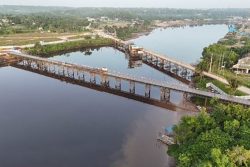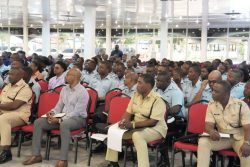It was reported last week that Mr Robert Persaud proposed the high cost of energy as the key constraint preventing the development of manufacturing in Guyana. He went on to blame the opposition for not supporting the Amaila hydroelectricity project, which had a price tag of almost US$1 billion. Recall that the IDB was yet to release its study on the project’s viability, yet the contract was signed and the infamous Fip Motilall road was long from complete. One study from an Argentinean consultancy observed that the hydro volatility would have been substantial, requiring thermal plants – heavy fuel generators currently used by GPL – to be used for the dry months. In other words, after spending US$1 billion, GPL would still need to operate generators in the dry periods.
The study by Mercados Energeticos Consultores is an example of private cost-benefit analysis, focusing only on the financial viability of the Amaila project from the perspective of the private investor. I am not aware of the government’s planners ever conducting a social cost-benefit evaluation so as to judge whether the project is good from the government’s perspective. If a social analysis was conducted, then perhaps the cost associated with running generators would also have been included in the cost projections. That cost has to be billed into the system at some point by the government. Therefore, it was far from certain whether Persaud’s silver bullet energy solution would have given the manufacturers the cheap energy they need. There are other serious methodological problems associated with the study mentioned above – for example the demand projections obtained by the time series econometric model (but that’s another issue for another day).
We know politicians prefer sound bites and one line answers. These are easy for party shills to run with. But while this column acknowledges the high cost of energy faced by businesses in Guyana, it will argue that there are other constraints facing the sector that are within the control of the government. There is no evidence to suggest that the government is serious about addressing them. Below are a few problems within the control of the government of the day.
 The first is the high cost of finance. Private commercial banks have a different investment horizon and purpose. Their purpose is not to take on the risks of industrial development. That’s for the society as whole to bear through a politically neutral industrial development bank. The average lending rate of around 14% is too high for manufacturers. Second, manufacturers will face the same crimes faced by all Guyanese. The cost of private security is too high because the government has failed to deliver a professional and effective police force after 22 years. Why keep harping about Amaila when crimes add a major element of risk and cost of doing business in Guyana?
The first is the high cost of finance. Private commercial banks have a different investment horizon and purpose. Their purpose is not to take on the risks of industrial development. That’s for the society as whole to bear through a politically neutral industrial development bank. The average lending rate of around 14% is too high for manufacturers. Second, manufacturers will face the same crimes faced by all Guyanese. The cost of private security is too high because the government has failed to deliver a professional and effective police force after 22 years. Why keep harping about Amaila when crimes add a major element of risk and cost of doing business in Guyana?
Third, the government has failed to upgrade the tertiary education capabilities of the population. The University of Guyana is a political football, there is no business school, the engineering schools need substantial improvements and programmes in the sciences and mathematics are not given the prominence they deserve. The technical schools are not producing the skills that can be absorbed easily in manufacturing. There is no focus on integrating a creative education (which the Americans call liberal arts) and the technical fields. Those studying competitiveness have observed how important innovations come about when there is the intersection of the liberal arts, sciences, engineering and mathematics. There is simply no leadership and vision coming from the Office of the President to change tertiary education for the better. We should not have to wait for the Amaila silver bullet before there is a complete overhaul of the university and technical schools.
Fourth, a main reason for the decline in manufacturing in Guyana has to do with flight of the Guyanese-born manufacturers. Foreigners will not be that keen to do it, preferring instead to extract natural resources. The government is yet to show leadership with a diaspora policy to encourage Guyanese to invest in this sector. Fifth, the deep water harbour is yet to be built. That will allow for larger ships to enter Georgetown, thus allowing for bulk economies that will lower cost of doing business. Instead, scarce financial resources are wasted on poor sequencing by building a new airport terminal and a hotel to compete with others who responded to the call to invest in hotels for Cricket World Cup.
Sixth, the small size of the Guyanese market, the small size of the Caricom market and the geographic spread of sister countries in Caricom imply fixed costs associated with manufacturing will not be dispersed over a large enough market. Also transport cost will be high to take Guyanese products to the far and small corners of Caricom. Therefore, the PPP will need to get its foreign policy together so as to help Guyanese products to break into North America. The government so far promotes a dubious foreign policy – for example, Mr Jagdeo cursing out the Americans once while in Iran. We have not seen tangible benefits to justify the costs associated with cursing the Americans.
Seventh, the government missed a major opportunity to dovetail manufacturing of housing components with the housing construction drive. With a clever industrial policy standardisation and codes could have been supported. Builders should have been encouraged to use Guyanese made components. Finally, political stability would have to be promoted by reforming the constitution and the electoral process. There is a natural inclination to destabilise. It is not in the interest of each of the main ethnic parties to see the other succeed. Ethnic chauvinism dictates that good ideas and projects be blocked for some political rationale. I know a few who opposed the Amaila project not because of its technical weaknesses as given above, but because a perceived East Indian government must never succeed. This kind of economic sabotage has been going on for decades. In the past it manifested itself in the burning of sugar canes, using GAWU as a political tool, and poisoning the minds of East Indians so that they do not participate in crucial institutions created by the PNC.
The system and constitution incentivise leaders not to cooperate. The only way to break this standoff is to change the legal setting so that those who lose the election know they either stand a good chance of winning the next one or they get an opportunity to determine the direction of the nation some system that shares power. It is simply not true that legal institutions and laws do not shape incentives.
Comments: [email protected]








